A home is often the single largest investment most people will make in their lifetime, and maintaining it properly is essential to preserving its value and livability. While it’s easy to focus on cosmetic improvements, routine home maintenance practices provide a much more critical benefit—they prevent small issues from developing into major, costly repairs. Regular upkeep not only safeguards your financial investment but also ensures that your living environment remains safe, comfortable, and energy efficient. Neglecting maintenance can lead to problems like water damage, mold growth, electrical hazards, and structural deterioration, all of which compromise both safety and property value. In this article, we’ll discuss why home maintenance is so important and explore ten essential areas of upkeep every homeowner should prioritize. From inspecting plumbing systems to preserving wooden features, these tasks form the backbone of a well-maintained home. By adopting consistent practices, you’ll not only save money in the long run but also enhance the longevity and functionality of your home.
1. Why is Routine Home Maintenance Important?

Routine home maintenance forms the foundation of a durable, efficient, and safe household. Just as a car requires oil changes and tune-ups, your home needs periodic care to operate effectively.
One of the main reasons to prioritize home maintenance is prevention. Regular checks allow you to catch minor issues before they escalate into costly repairs. For example, identifying moisture buildup early can prevent mold infestations or structural damage. The same applies to maintaining systems like your underground oil tank, where regular inspections can help avoid leaks that may lead to environmental hazards and expensive cleanup operations.
Fixing small problems before they worsen is far cheaper than undertaking major renovations. Replacing a worn-out weather seal is minimal in cost compared to repairing water damage caused by a leak. Preventive care saves thousands of dollars in potential repair bills.
Neglecting maintenance can create dangerous living conditions. Faulty electrical wiring, broken locks, and deteriorating roofing can all compromise safety. Routine checks ensure that your home remains secure against both natural and man-made risks.
Every component of your home, from the foundation to the appliances, has a lifespan. Maintenance practices extend the life of these features by minimizing wear and tear. For instance, proper HVAC servicing prevents breakdowns and improves performance, ensuring comfort for years.
Well-maintained homes are more attractive to potential buyers. Prospective homeowners are willing to pay a premium for a property that requires minimal immediate repairs. Regular upkeep ensures your home retains and even increases its market value.
2. How Often Should You Conduct a Home Inspection?
Knowing when to inspect your home is just as important as knowing what to inspect.
Seasonal changes bring new challenges. Conducting inspections before summer and winter helps prepare your home for extreme temperatures. Spring is ideal for checking for winter damage, while fall is perfect for readying your home for cold weather.
While DIY inspections help with minor issues, professionals bring specialized knowledge. For example, septic tank cleaning services often require certified experts who understand how to spot early warning signs and provide proper care.
Older homes or those in harsh climates may require more frequent checks. Homes in humid regions, for instance, are more prone to mold growth, while those in cold regions face risks of frozen pipes.
A detailed checklist ensures no area is overlooked. Include items such as electrical panels, roofing, plumbing fixtures, and insulation. Organized inspection routines reduce the chance of missing small but critical problems.
Basic tools such as flashlights, moisture meters, and ladders are helpful for homeowners. Professional inspectors use advanced tools like infrared cameras to detect hidden leaks or electrical hot spots.
3. What Are the Benefits of Regularly Cleaning Your Gutters?
Gutters are often overlooked until problems arise, but they play a crucial role in home maintenance.
Gutters channel rainwater away from your home’s foundation. Clogged gutters cause water to overflow, leading to basement flooding and structural damage. Installing features like under deck drain systems can also improve water management.
Standing water in blocked gutters attracts mosquitoes and other pests. Rodents and birds may also nest in debris-filled gutters, causing additional issues.
Overflowing gutters can wash away soil, mulch, and plants. Consistent cleaning helps preserve your landscaping efforts and prevents erosion.
Blocked gutters trap moisture along the roofline, leading to shingle deterioration and wood rot. Clean gutters prolong the life of your roof.
Uncontrolled water runoff weakens foundation walls, leading to cracks and instability. Proper gutter maintenance ensures water is directed safely away from your home.
4. How Do You Maintain Your HVAC System?

Heating, ventilation, and air conditioning (HVAC) systems are central to comfort and energy efficiency.
Filters should be replaced every one to three months to maintain air quality and system efficiency.
Annual servicing by a professional technician is recommended. Many homeowners work with a roofing company simultaneously to schedule roof and HVAC inspections, ensuring overall efficiency.
Programmable thermostats require periodic battery changes and recalibration. This small task prevents major energy losses.
Clean ducts improve airflow and reduce allergens. Sealing leaks enhances efficiency and lowers utility bills.
Regular servicing ensures your HVAC system runs smoothly, minimizing energy consumption and costs.
5. What Should Be Included in a Routine Plumbing Check?
Plumbing systems often go unnoticed until problems occur.
Inspect sinks, toilets, and exposed pipes for drips. Even minor leaks can waste thousands of gallons annually.
Low or high pressure indicates underlying problems. Professionals may suggest adjustments or repairs.
Slow drains may signal clogs or more serious issues in the main line. Clearing blockages promptly prevents backups.
Check for sediment buildup or uneven heating. Some paving contractors also advise combining driveway inspections with plumbing checks since water leaks can damage pavement.
Older homes may have outdated pipes like galvanized steel, which corrode over time. Modern alternatives such as PEX are easier to maintain.
6. Why Is Roof Maintenance Crucial?
The roof is your home’s first line of defense against the elements.
Look for curling, missing, or cracked shingles. Prompt replacement prevents leaks and structural damage.
Small leaks often go unnoticed until major damage occurs. Regular inspections help catch them early.
Flashing around chimneys and vents is prone to deterioration. Ensuring proper sealing prevents water infiltration.
Leaves, branches, and dirt should be removed regularly. This prevents water pooling and roof damage.
By working with professionals, such as local well pump services that also handle water drainage near homes, you can coordinate maintenance efforts that support both roof longevity and overall water management.
7. How Do You Preserve Wooden Elements in Your Home?

Wood adds warmth and beauty but requires consistent care.
Applying sealants or varnishes shields wood from moisture and sunlight, reducing wear.
Early detection of wood rot or termite infestations prevents structural damage. Regular inspections are key.
Wood naturally expands and contracts. Proper installation and maintenance minimize cracking and warping.
Avoid harsh chemicals that strip finishes. Gentle cleaners maintain appearance without damage.
Scheduling inspections for stairs, decks, and flooring helps identify repair needs early. Homeowners often pair this with wood floor refinishing services to maintain aesthetics.
8. What Role Do Windows and Doors Play in Home Maintenance?
Windows and doors are vital for insulation, security, and energy efficiency, making their maintenance a priority for every homeowner. They act as barriers against outside weather, intruders, and noise pollution while also contributing to your home’s overall appearance and value.
Inspect caulking and weatherstripping regularly to prevent drafts and moisture intrusion. These small materials can deteriorate over time, leading to increased energy bills and potential water damage inside the home.
Ensure locks, handles, and hinges function smoothly. This not only enhances daily convenience but also ensures your home remains secure. Upgrading outdated locks with modern smart-lock technology can provide an added layer of safety.
Cracks and chips should be repaired promptly to prevent breakage and avoid compromising insulation. Clean glass improves curb appeal while allowing more natural light into your home.
Poorly maintained windows and doors lead to significant energy inefficiency. Double-paned or energy-efficient models reduce heating and cooling costs, while storm doors and windows provide extra protection during extreme weather conditions..
Lubricating hinges, tracks, and sliding door rollers ensures smooth operation and prevents long-term wear. Skipping this step can lead to costly repairs or replacements.
Beyond basic function, windows and doors also play a major role in home safety and style. Decorative doors and modern window designs increase property value while contributing to comfort and livability. Many homeowners pair window and door upgrades with asphalt paving projects to improve curb appeal, giving the home a refreshed, well-maintained look. By paying attention to these essential features, you protect your home’s efficiency, safety, and beauty for years to come.
9. How Can Landscaping Affect Home Maintenance?
Your yard plays a significant role in home care, extending far beyond aesthetics. Proper landscaping practices directly impact the durability and safety of your property. Neglected lawns or poorly placed plants can cause long-term problems, while thoughtful landscaping creates a healthier environment for both your home and family.
Healthy lawns prevent erosion and enhance curb appeal. Regular mowing, fertilization, and aeration not only keep your yard looking good but also promote soil health, which supports strong root systems and prevents bare patches that could invite pests or weeds.
Overgrown branches can damage roofs, siding, or power lines during storms. Pruning trees and shrubs ensures safety and prevents costly repairs. Removing dead or diseased branches also reduces the risk of infestations spreading to other parts of your yard.
Proper landscaping keeps soil in place, protecting your foundation. Installing ground cover plants, retaining walls, or mulch beds can stabilize soil and help channel water away from the home’s base, reducing the risk of cracks or settling.
Poor drainage can lead to flooding, basement leaks, or water intrusion. Landscaping design, including grading and the installation of French drains, helps direct water safely away. Many homeowners schedule drainage improvements at the same time as other seasonal tasks, such as water heater repair, to streamline upkeep.
Strategic plant placement enhances security by eliminating hiding spots near windows and doors. At the same time, tall hedges or privacy trees can add seclusion and improve property value. Thoughtful landscaping contributes to both safety and comfort while making your outdoor areas more enjoyable year-round.
10. Why Is It Important to Maintain Home Safety Systems?

Safety systems protect your home and loved ones, serving as the first line of defense against emergencies. Whether it’s fire, break-ins, or hazardous gas leaks, a well-maintained safety system can mean the difference between a minor incident and a devastating loss. Homeowners often underestimate the importance of routine checks until it’s too late.
Test alarms monthly and replace batteries annually to ensure functionality. These devices save lives by providing early warnings that allow families to act quickly.
Check expiration dates and replace extinguishers as needed. A non-functional extinguisher during an emergency is useless, so keeping them charged and accessible is essential.
Test cameras, alarms, and locks regularly for peace of mind. In today’s world, modern systems also integrate with smart home technology, which requires periodic updates to maintain compatibility and effectiveness.
Revisit emergency plans with your family at least once a year. Assign roles for each family member so everyone knows what to do in different situations, whether it’s a fire, flood, or severe storm.
Practicing drills keeps everyone prepared. Fire, earthquake, and even home invasion drills build confidence and muscle memory for emergencies. Partnering with an insulation expert during home inspections also ensures fire safety through proper insulation management. In addition, consider reviewing your first-aid kits and emergency supplies to make sure they’re stocked and up to date. Having flashlights, batteries, water, and non-perishable food ready can make your home much safer and more resilient in an unexpected situation.
Conclusion
Home maintenance is a continuous responsibility that pays off in comfort, safety, and financial savings. By addressing issues early and performing regular upkeep, you extend the life of your home’s features and protect its overall value. From roof inspections to plumbing checks, every task plays an important role in creating a safe, efficient, and welcoming living environment. By committing to these ten key practices, you ensure your home remains not only a sound investment but also a place where you and your family can thrive for years to come.


